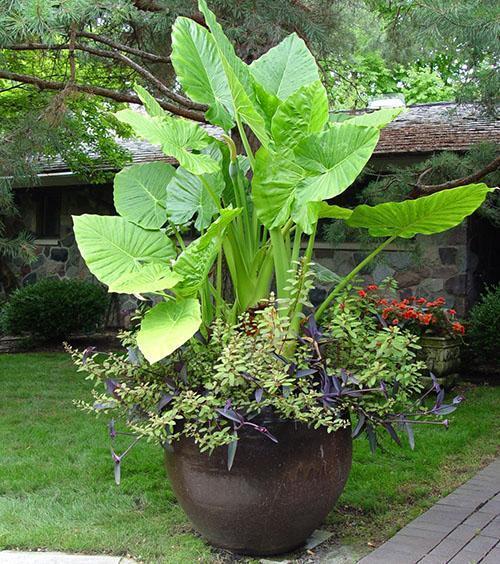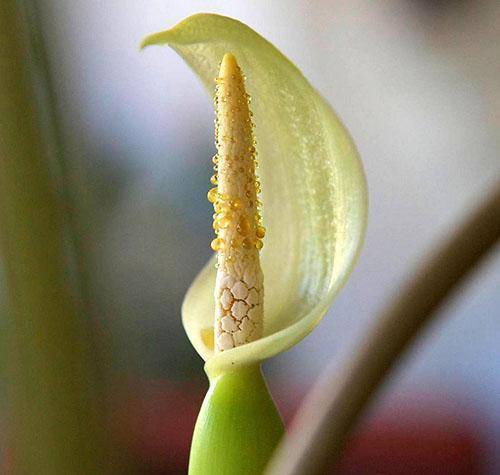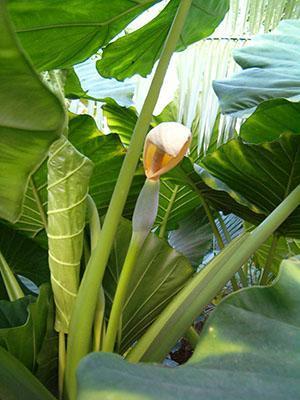The most interesting information about room alocasia
 Every year, more and more exotic, until recently unknown plants appear in the collections of Russian amateur flower growers. Thanks to the development of transport links between countries, shops offer varieties and species of plants from different parts of the world. Among this variety there are amazing indoor alocasia, lithops, violets, spathiphyllums.
Every year, more and more exotic, until recently unknown plants appear in the collections of Russian amateur flower growers. Thanks to the development of transport links between countries, shops offer varieties and species of plants from different parts of the world. Among this variety there are amazing indoor alocasia, lithops, violets, spathiphyllums.
To date, botanists have discovered and described more than seven dozen original species of alocasia, which are naturally widespread in the humid subtropics and tropics of the Asian and Pacific regions. And if large plants, for example, alocasia large-rooted and odorous, were discovered in the first half of the 19th century, then small specimens, which include copper-red or foggy alocasia, are just beginning to reveal their secrets and charms to flower growers in Europe, America and, of course, Russia.
How does alocasia bloom?

 For some growers who do not know how alocasia blooms, the formation of a peduncle is a real surprise. However, the appearance of a dense white or creamy yellow cob-inflorescence is possible on both large species and miniature indoor alocasia.
For some growers who do not know how alocasia blooms, the formation of a peduncle is a real surprise. However, the appearance of a dense white or creamy yellow cob-inflorescence is possible on both large species and miniature indoor alocasia.
The inflorescence, consisting of many small flowers, is wrapped in a perianth leaf. Depending on the type, such a blanket can be greenish, white or even brown.
Until pollination occurs, the perianth remains fresh and attracts the attention of insects, then it withers, and red or orange small berries appear in the place of the inflorescence.
 If in the wild, where there is no shortage of moisture and nutrition in the tropical forest, flowering does not cause serious damage to the plant, then indoor alocasia is experiencing serious difficulties. While the flower stalk is forming and growing, alocasia, suffering from a lack of nutrition, can shed all the leaves, and flowering lasting 6-10 days completely depletes the indoor culture.
If in the wild, where there is no shortage of moisture and nutrition in the tropical forest, flowering does not cause serious damage to the plant, then indoor alocasia is experiencing serious difficulties. While the flower stalk is forming and growing, alocasia, suffering from a lack of nutrition, can shed all the leaves, and flowering lasting 6-10 days completely depletes the indoor culture.
Therefore, when growing alocasia, it is recommended to remove a large bud or let the inflorescence show off for only a couple of days. What other conditions need to be created for a tropical plant to be comfortable in an ordinary city apartment?
Features of growing alocasia
 The habitual habitat for all types of alocasia, today grown as indoor crops, are tropical forests, banks and marshy lowlands of rivers, moist dense undergrowth. Plants grow and thrive in tropical climates. Therefore, at home, growing alocasia, the pet needs to create a similar environment.
The habitual habitat for all types of alocasia, today grown as indoor crops, are tropical forests, banks and marshy lowlands of rivers, moist dense undergrowth. Plants grow and thrive in tropical climates. Therefore, at home, growing alocasia, the pet needs to create a similar environment.
In the spring-summer period, a heat-loving culture will be comfortable at temperatures from 18 to 26 ° C. In winter and autumn, during a period of relative rest, air warmed up to 16–20 ° C is acceptable for alocasia. But even if the temperature regime is observed, disease and death of the plant cannot be ruled out if the air is 60–65% drier. Such humidity can be maintained with the help of technical and improvised means, as well as regularly spraying and wiping the foliage of room alocasia.
Irrigation of the green part of the plant is not carried out only in winter and when the air is sufficiently cold.
The best place to grow alocasia is in the east or west windows, where there is enough light, but it will not be able to burn the ornamental leaves habitual to moisture. If in summer the plant needs artificial shade on the southern windows, then in winter alocasia will be completely comfortable here.
 In spring, summer and early autumn, when the temperature permits, the plants are watered frequently and abundantly. Watering is better carried out several times, waiting for the moisture to wet the entire earthen lump and removing the excess that has drained into the pan. Indoor alocasia needs watering when the top layer of the substrate is dry enough.
In spring, summer and early autumn, when the temperature permits, the plants are watered frequently and abundantly. Watering is better carried out several times, waiting for the moisture to wet the entire earthen lump and removing the excess that has drained into the pan. Indoor alocasia needs watering when the top layer of the substrate is dry enough.
Indoor alocasia are transplanted in early spring, carefully transferring the earthen lump into a larger pot and adding a fresh nutrient substrate to the container. If a young specimen grows in the house, the procedure is carried out annually. Adult plants are transplanted two or three times less often.
In the spring, and then in the summer, when the plant is actively developing, alocasia is fed with complex compounds, including nitrogen and mineral supplements.
In winter, you do not need to fertilize alocasia. In addition, in the cold season, they reduce the intensity of watering and try to protect the pets from drafts.
 The soil for alocasia is chosen light, nutritious and loose. At home, it is convenient to mix ready-made soil for orchids with well-cleaned peat. In the pot, a reliable drainage must be arranged, which ensures the outflow of excess moisture and protects the plant roots from decay. If you follow all the requirements and rules, growing alocasia will not be difficult even for a novice florist.
The soil for alocasia is chosen light, nutritious and loose. At home, it is convenient to mix ready-made soil for orchids with well-cleaned peat. In the pot, a reliable drainage must be arranged, which ensures the outflow of excess moisture and protects the plant roots from decay. If you follow all the requirements and rules, growing alocasia will not be difficult even for a novice florist.
You can get a new plant at home using seeds obtained from an existing copy of cuttings and small daughter nodules for planting. rhizomes of an adult specimen are also often used for reproduction.
At the same time, the florist should remember that most indoor alocasia are hybrids, therefore, when propagating by seeds, it is not always possible to preserve parental traits.
 Since the juice of room alocasia, regardless of the type and variety, contains caustic oxalates, toxic to humans, all work with the flower is carried out only with gloves.
Since the juice of room alocasia, regardless of the type and variety, contains caustic oxalates, toxic to humans, all work with the flower is carried out only with gloves.
What does alocasia bring home?
 Bioenergy experts claim that indoor alocasia is able to withstand harmful radiation.
Bioenergy experts claim that indoor alocasia is able to withstand harmful radiation.
 Under the influence of the active energy of the flower of alocasia, the work of the nervous system and the hormonal background are normalized, the tone of a person and his general well-being improve. The plant can be of particular benefit to representatives of the signs of Aquarius and Pisces. If a room alocasia is installed in the office of such a person, it will be easier for him to concentrate, collect his thoughts, defend his beliefs and create something new.
Under the influence of the active energy of the flower of alocasia, the work of the nervous system and the hormonal background are normalized, the tone of a person and his general well-being improve. The plant can be of particular benefit to representatives of the signs of Aquarius and Pisces. If a room alocasia is installed in the office of such a person, it will be easier for him to concentrate, collect his thoughts, defend his beliefs and create something new.
Alokazia brought into the house will help to resist the attacks of enemies, will become a kind of green protection for the family. The best place for such a plant is a spacious living room or study. In the latter case, it is reasonable to prefer small varieties of alocasia, for example, pay attention to Black Corduroy or Dragon Skin.
 Indoor alocasia are used in interiors of public buildings, in meeting rooms and halls.
Indoor alocasia are used in interiors of public buildings, in meeting rooms and halls.
The only place where you shouldn't put alocasia is sleeping rooms and children's rooms, because plants contain harmful, irritating mucous membranes that can harm health upon contact.
How is alocasia useful?
 It is believed that the first specimens with leaves in the form of elephant ears grew in winter gardens belonging to the Russian Imperial House. It is possible that it was so. Moreover, in the translation and interpretation of the ancient Chinese book on the benefits of medicinal herbs, made by the famous Peter Badmaev at the turn of the 20th century, much attention is paid to the beneficial properties of the outlandish alocasia at that time.
It is believed that the first specimens with leaves in the form of elephant ears grew in winter gardens belonging to the Russian Imperial House. It is possible that it was so. Moreover, in the translation and interpretation of the ancient Chinese book on the benefits of medicinal herbs, made by the famous Peter Badmaev at the turn of the 20th century, much attention is paid to the beneficial properties of the outlandish alocasia at that time.
If alocasia were grown in the greenhouses of the Winter Palace, then these were specimens of the type of odorat or makroriz, reaching a height of 2-3 meters, with juicy thick stems, large round-heart-shaped green leaves and powerful erect petioles. It is these plants that are rightfully called medicinal alocasia.
But today it is difficult to place such large crops in an apartment, so dwarf or miniature varieties are of increasing interest. Indoor alocasia are very diverse, their height ranges from 40 to 60 cm, more often such species have arrow-shaped or oval leaves with an unusual decorative surface. These plants, although beautiful, will not bring health benefits.
 Why is alocasia useful? It turns out that the plant is a powerful immunostimulating agent. At home, it is used as an anesthetic and locally irritating drug.
Why is alocasia useful? It turns out that the plant is a powerful immunostimulating agent. At home, it is used as an anesthetic and locally irritating drug.
Chinese traditional medicine considers the tincture of the roots and stems of alocasia as a large horse medicine for vascular and rheumatic diseases.
Alocasia juice, ointments and decoctions on its basis are also recommended for tumor diseases. Although official medicine, which has carried out long-term in-depth studies of the properties of the plant, has not come to a common conclusion, what is the use of alocasia.
Do not forget that the use of the plant for medicinal purposes is possible only after consultation with doctors, as well as if all precautions are taken. Otherwise, severe burns and complications of existing ailments cannot be avoided.
Hurrah! In the third year, alocasia blossomed in me - incredible, but true. Suddenly, beautifully, pleasing to the eye.